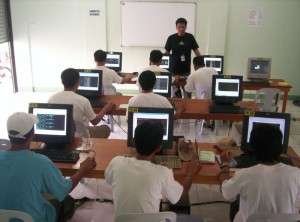How to Provide Effective Employee Training

Providing a good training program is essential to any job. Making sure your company knows exactly how to provide effective employee training, will in turn lead to greater success for you and your organization.
Providing Employee Training
It is critical to incorporate formalized training in your operational strategy. Training activities, whether classroom or on-the-job must have willing participants and enthusiastic instructors. Along with the enthusiasm, the instructor must be a subject matter expert or at least have subject knowledge a couple of levels beyond the trainee.
Classroom Training
Since what most companies struggling with the question of how to provide training are lacking is formal classroom training, let’s focus on this aspect as we discuss “how.”
First it is important to understand that many adults fear going into a classroom setting for training. This can bring back some unpleasant memories for them. It is important to communicate that this is not “high school, tech. school, or college.” Making training mistakes is common, In fact, if your not making mistakes, then your not really learning anything are you?
Let them know they cannot fail and will not receive a grade. Yes, they may be asked to complete an evaluation following the training. Such an evaluation is to determine not only how much they learned, but how good the instructor was. This information is used by the instructor and the company to continually improve what is being presented.
Training Location
Now that you have put the attendees at ease, you need a training location and a classroom. After all, learning is not all in your head and the surroundings are very important to training effectiveness. It is usually better to take people off-site.
This way there are fewer interruptions. Their boss or co-worker does not interrupt to have them “fix” a problem, they are not being paged, and when you call a break, they do not run to a computer. Also, when a training session is held off-site, it provides a break from the normal routine and makes the day special. Care should be taken to get a room that fits the number of attendees.
You don’t want to be too crowded or too spread out. If there is a choice, avoid classroom style seating. For example, use tables or desks in a “U” shape, with the instructor in the middle. Or use tables with three participants to a table, rather than desks. Ensure the room has the correct accessories; dry erase boards, flip charts, video connections, a screen that drops down and stays down, etc.
Student Dress Code
Communicate, with sufficient notice, both the dress code and what the participants are to bring to the training. Ensure the participants are comfortable. Most formal training sessions require business-casual attire, but if jeans are acceptable let the attendees know this fact. The student dress code can be a factor that influences learning.
Request some level of punctuality from the participants. Try to avoid the time clock mentality. Rather, put the attendees on the honor system to be on time, while stressing the importance as to why their attendance and punctuality is important. Instructors should never be late, unless it cannot be avoided.
 Training Duration and Breaks
Training Duration and Breaks
Typically, formal training sessions last between three and eight hours. Sufficient breaks are crucial to keeping the participants alert. Different people may learn differently, but they all need breaks. Schedule breaks every 1 1/2 to two hours.
Ten to fifteen minutes for break is usually plenty of time. Since the participants are all adults, it is okay if someone excuses themselves for an unscheduled break to use the restroom. Instructors should not be upset if a participant briefly steps out at an unscheduled time. Instructors could also take this as a hint that maybe it is time to take a break.
Training Snacks
If possible, have snacks in the training room. Fruits, light pastries, bagels, coffee, tea, water, juice in the morning; fruits, cheeses, water, and soda in the afternoon. This will help you make employee training a success.
Avoid heavy snacks with heavy carbohydrates; jelly donuts, large pastries, cakes, etc. These will cause the participants to become drowsy. If the snacks and beverages are located in the training room, it makes the training more special, fun, and allows the participants to do something else on the scheduled breaks as opposed to going to the soda machine.
Training Lunch
Lunch can be either brought into the training room or the participants can go to a nearby restaurant. Boxed lunches are very popular for training sessions. A menu is typically passed around by mid-morning for the participants to pick their choices for lunch. I prefer going out of the training area for lunch. This gives the instructor and participants a chance to really get out and move around. I prefer to walk to a nearby restaurant, rather than drive, whenever possible.
The participants may go to lunch as one large group or split into small groups, with each going to a location of their choice. Regardless of whether the lunch is brought in or if the participants go out, the lunch should be paid for by the sponsoring company or included in the cost of the training.
Instructional Materials
The most effective training sessions provide all materials needed for the participants. Pens, pencils, highlighters, markers, writing paper, and course specific materials should all be provided by the instructor. A multitude of choices should be provided for the participants. Several colors of markers and highlighters allow the participants to customize their notes.
You may improve the effectiveness of your training by employing less lecture time and more interaction time. Additionally, use some form of a handout or instruction manual is necessary for any training class. However, the participants’ focus should be on the instructor and whatever the instructor is using for visual presentation; computer presentation, flip chart, or dry erase board. Instructors should also supplement the main handout or text with topical sheets that are handed out to participants as the subject is discussed.
It is also nice for the participants to leave with something extra. A mall booklet or similar item related to the subject matter is usually well received. I like to have prize drawings for all participants that return on time from breaks and lunch. While some of the “prizes” are humorous, some are serious and related to the subject matter or similar topics.
Training Certificate
Finally, provide each participant with a certificate of completion signed by the instructor. Before handing these out have all participants complete an anonymous course evaluation. This feedback, while it may at first ruffle a few feathers, can only help the instructor and the class to get better and increase your training performance.
Providing Effective Training
Once you have taken into consideration all of these training elements, your company should know exactly how to increase your training performance!
















“””What a perfect writing! I love the content!
Reading this article helped me understand how to provide effective employee training since I am a trainer in our company.
Do you think that it’s also important on doing short quizzes daily for knowledge check?
Such beautiful writing this is. I appreciate your talent.”””